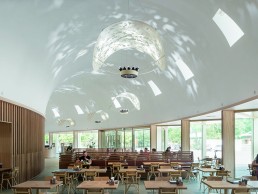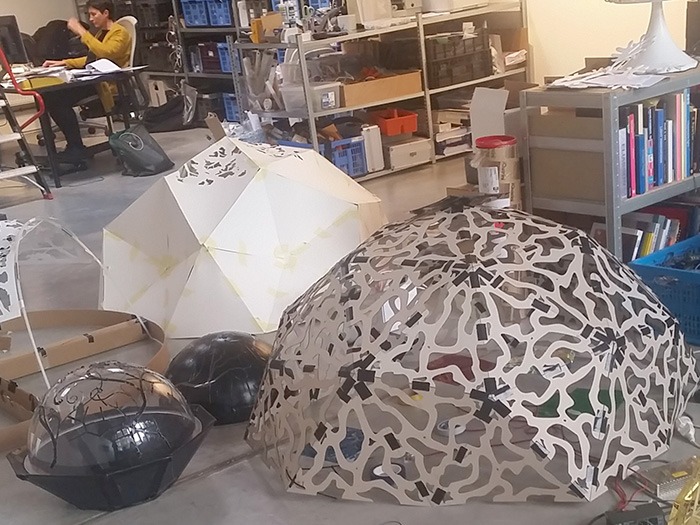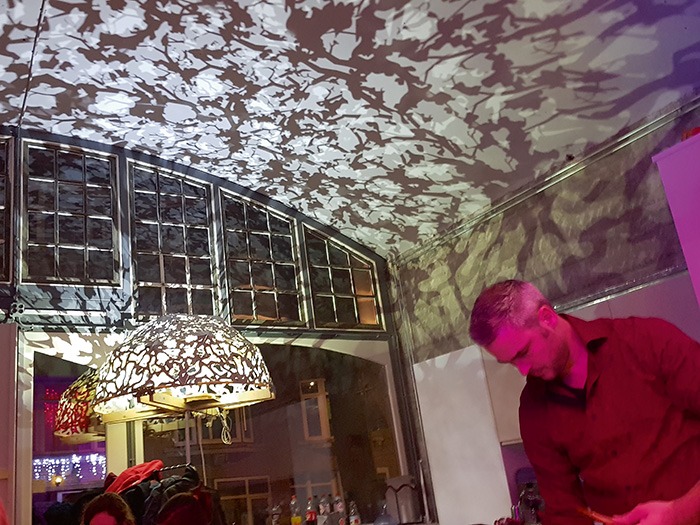
Park Pavilion, Netherlands
Lighting Design firm Beersnielsen create stunning cut-metal chandeliers for the Park Pavilion at Hoge Veluwe National Park, Netherlands – drawing the outside-in.
The new Park Pavilion is located in the heart of the Hoge Veluwe National Park in Otterlo, Netherlands. An architectural sculpture and striking landmark, it provides walkers and visitors with a rest stop during their visit. The pavilion, opened at the end of June, by King Willem-Alexander, offers visitors a destination within the forest and houses a restaurant, shop, education and reception areas for varied functional uses.
Designed by a collaborative team of architects from De Zwarte Hond and Monadnock in Rotterdam, with interior design coming from Vosinterireur, in Groningen, the striking and modern building has a scandi-style to it and fits perfectly into the forest surroundings of the National Park. The pavilion is an elongated, open-plan curved space with a high vaulted ceiling and fireplace at one end for the winter months.
“A key point of departure for the architects was that the entire building must form an integral part of the landscape and the park experience,” explained the Zwarte hond team. “This is not only reflected in the design itself, but also in the collaboration with lighting specialists and interior designers. The entire building reflects the direct connection with the surrounding natural landscape of the Hoge Veluwe.
“Like the building itself, the interior forms an alliance with the surrounding landscape. Visitors entering the high space with curved walls, will be surprised at how the glass wall presents an ever-changing view of the Veluwe. Above their heads, the vaulted ceiling extends over the entire length of the space.”
Lighting design firm Beersnielsen, also from Rotterdam, completed bespoke lighting features for the space, drawing the outside-in. Nine chandeliers project an intricate pattern of nature onto the high ceiling, forming a light installation based on the sun shining through the leaves in a forest, as well as demonstrating an example of biophilic design. The patterns draw nature into the building and form a connection between the physical and the virtual world.
The pavilion’s structure at 60-metres long and 7.5-metres high, with its large glass windows, proved a challenge for the lighting team during the initial design process. As well as dealing with large amounts of daylight, the team also had to take the idea of telling a story through an experience and feeling, rather than through physical content.

Juliette Nielsen, lighting designer at Beersneilsen and Amabassador in Netherlands for Women in Lighting, tells darc: “De Zwarte Hond and Monadnock architects won the competition with a design for the pavilion that had a vaulted ceiling, which they proposed to use for ‘telling stories about the park and its history. The inital idea was that the content should change, so couldn’t be painted or printed on. Their first thought was to use some sort of LED screen/mesh or a beamer projection.
“However, we felt this was not appropriate for a pavilion in the heart of a nature park and so proposed to use the ceiling as a canvas for a more subtle, natural experience, and tell the story via light, colour and shadow patterns.”
As such, the Beersnielsen team carried out numerous tests and created multiple prototypes to explore varied ideas of light installation. Alongside Juliette Nielsen, Beersnielsen designers Wim aan de Stegge, Mieke van der Velde, Charl Smit and Sjoerd van Beers experimented with various light projections and shadow play options in a scale model of the pavilion to get an idea of what worked on the high, curved ceiling. They then devised some true-to-scale dome-shaped prototypes that were tested in the pavilion during its construction.
“We also had to work around the challenge of getting the physical design right – the size, shape, patterns, material, colour and so on – as the chandelier would also have a big visual impact on how the space is perceived,” continued Nielsen. “Both the architects and interior designers had their own opinions about the design, so it was key to work together to accomplish the desired effect.”

These tests all influenced the final designs used for the scheme and the earlier dome-shaped, standing lamp evolved into to a Pringle-like hanging pendant, that has a mixture of shapes and patterns of small birds and animals cut into the metal canopy. Each pendant includes 20 individual light sources that are fully dimmable to create dynamic and natural feeling movements, such as water rippling or trees moving in the wind.
Reflecting on the project now it is completed, Nielsen said: “We received great reactions from visitors – some even felt the architecture was designed around the fixtures and that the lighting gives a subtle and natural vibe to the space without being too present.”
www.beersnielsen.nl
www.dezwartehond.nl / monadnock.nl
www.vosinterieur.nl



